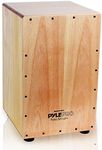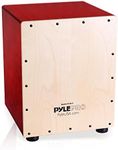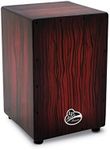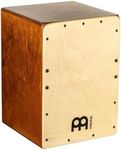Buying Guide for the Best Cajon Drum Box
Choosing a cajon drum box is an exciting process because this instrument is both versatile and portable. The right cajon can be used for a variety of music styles, from flamenco to pop, and is great for both beginners and experienced percussionists. When picking a cajon, it's important to consider how and where you'll use it, what kind of sound you prefer, and your comfort while playing. Understanding the key features will help you find a cajon that matches your musical needs and playing style.MaterialThe material of a cajon affects its sound and durability. Most cajons are made from different types of wood, such as birch, beech, or mahogany. Harder woods tend to produce a sharper, more defined sound, while softer woods can give a warmer, mellower tone. If you want a bright, punchy sound for genres like pop or rock, look for a cajon made from harder woods. For softer, more acoustic settings, a cajon with softer wood might be more suitable. Think about the music you want to play and choose a material that complements that style.
Size and DimensionsThe size of the cajon influences both the sound and how comfortable it is to play. Larger cajons usually have deeper bass tones and more volume, making them suitable for performances or playing with other instruments. Smaller cajons are more portable and can be easier for children or smaller adults to play, but they may have less bass. Consider your body size and whether you need to carry the cajon around often. If you want a strong bass and don't mind a bigger box, go for a larger size. If portability and comfort are more important, a smaller cajon might be best.
Snare SystemMany cajons have a snare system inside, which adds a crisp, buzzing sound similar to a snare drum. Some cajons have fixed snares, while others have adjustable or removable snares. Fixed snares are simple and always ready to play, but you can't change the sound much. Adjustable snares let you customize the amount of buzz, and removable snares allow you to play with or without the snare sound. If you want versatility and like to experiment with different sounds, look for a cajon with adjustable or removable snares. If you prefer a consistent, classic sound, a fixed snare might be enough.
Sound Hole PlacementThe sound hole is usually on the back of the cajon, but some models have it on the side or even the front. The placement affects how the sound projects and how the bass feels. A rear sound hole gives a traditional sound and projects the bass backward, which is good for solo playing or small groups. Side or front sound holes can make the cajon sound louder to the audience and can change the feel of the bass. Think about where you'll be playing most often—if you play in larger spaces or with a band, a different sound hole placement might help your sound carry better.
Playing Surface (Tapa)The tapa is the front surface of the cajon where you strike to make sound. The thickness and type of wood used for the tapa affect the sensitivity and tone. Thinner tap as are more sensitive and respond to lighter touches, which is great for detailed finger work and softer playing. Thicker tap as are more durable and can handle harder hits, making them suitable for louder playing. If you like to play with subtlety and dynamics, look for a cajon with a thinner, responsive tapa. If you play more aggressively or need durability, a thicker tapa might be better.
Non-Slip Feet or PadsNon-slip feet or pads on the bottom of the cajon help keep it stable while you play and protect both the instrument and the floor. Some cajons come with rubber feet or pads, while others may not. If you plan to play on smooth surfaces or move around a lot while playing, non-slip feet can make a big difference in comfort and safety. If you mostly play in one place or on carpet, this feature might be less important, but it's still a nice addition for most players.


















